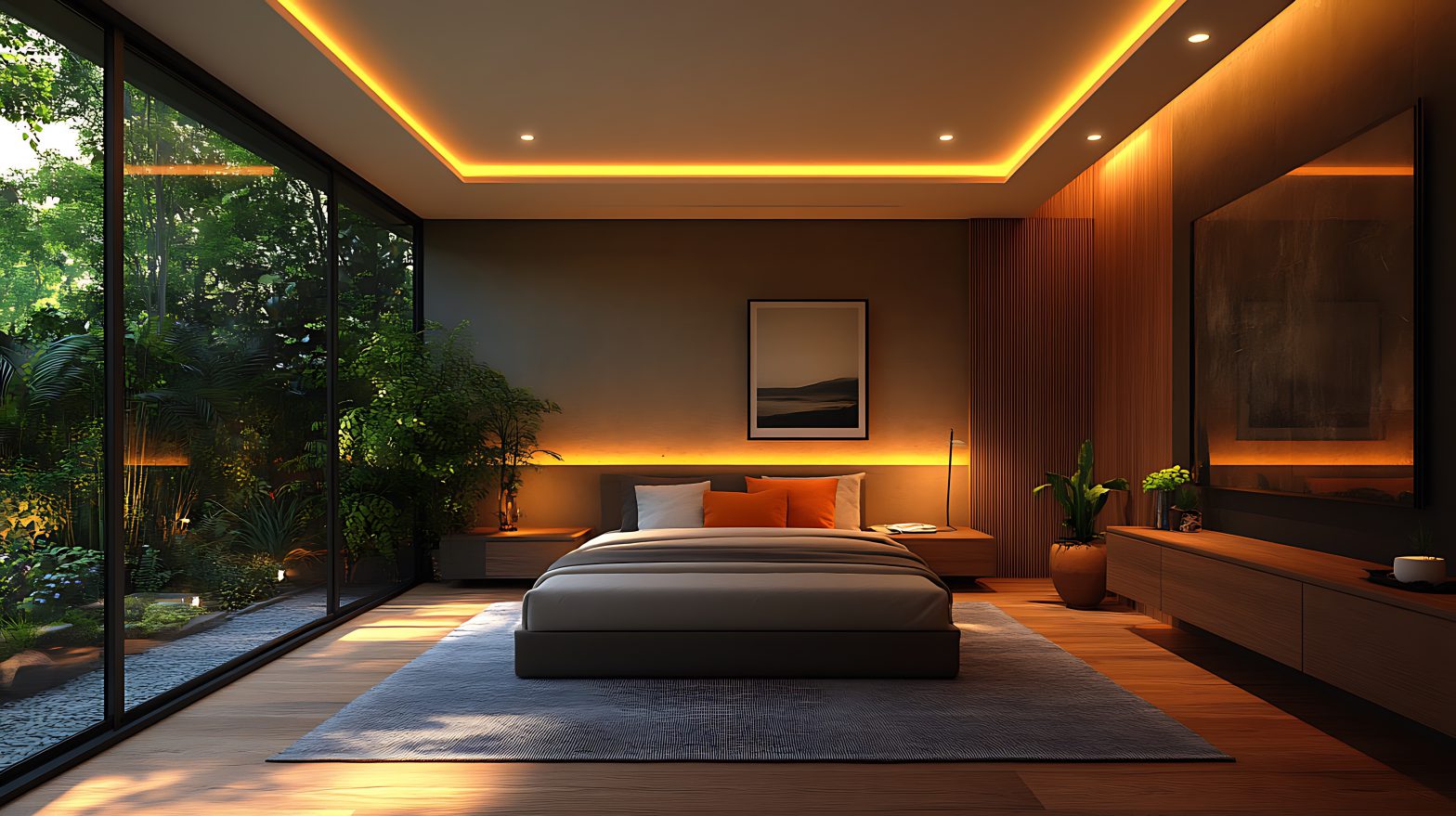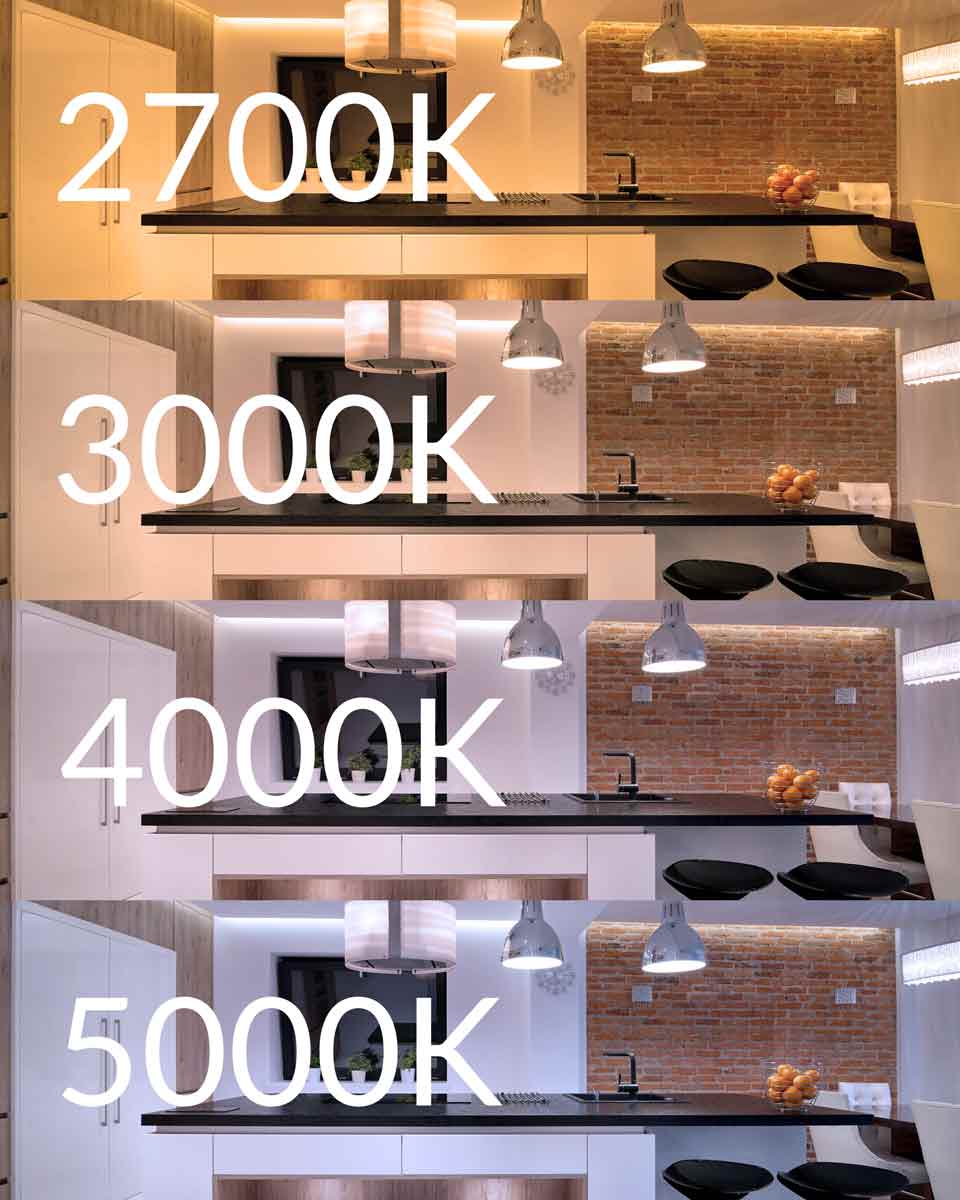
What LED strip light color temperature should I choose?
During your search for a white LED strip, you may have come across color temperature ratings. Not sure what it means or what to pick? Read on to find out!
Color temperature is a way to describe the color of light emitted by a light source. It is measured in degrees Kelvin, with lower color temperatures being a warm, yellowish-red color, and higher color temperatures taking on a bluish tone.

Below are some common color temperatures with reference points that should be familiar to you:
1900K: candlelight
2700K: incandescent light bulb (warm white)
3000K: halogen light bulb
4000K: "neutral white" fluorescent light bulb
6500K: "daylight white" fluorescent light bulb; natural daylight (cool white)
There is no such thing as a single "best" color temperature when choosing LED strip lights. That is because for each type of application, a different type of light is desired. Below are the most commonly offered color temperatures and their potential uses:
2700K: perfect for bedrooms and other interior applications where a warm, inviting atmosphere is desired
3000K: areas where a slight more energized environment is desired can benefit from 3000K color temperature LED strip lights. Museums, art galleries, restaurants, hotels and other high-end spaces are also great candidates for this color temperature.
4000K: the majority of retail fixtures and store interiors, are good places to install 4000K. Commonly considered a midpoint between warm white and cool white, this is a good compromise if you don't like the harshness of cool white but also want to avoid too much yellow in a warm white space.
6500K: applications that need to simulate natural daylight should use 6500K. Film, photography and industrial applications should fall under this category.
The color temperature scale sounds counter-intuitive at first - how can it be that warm white is a lower temperature than cool white? Perhaps some understanding of the way the color temperature scale was developed may be helpful.
Color temperature is based on the concept of black body radiation. Black bodies are theoretical entities that emit different colors of light depending on their temperature.
While not a perfect black body radiator, a hot block of coal acts similarly. At lower temperatures, it will emit a dull, red glow. As its temperature increases, it will begin to appear a more brilliant white. If we continue to heat it up, it will reach a state where it will begin to have a blue tint.
Color temperature is therefore the color that a black body radiator would have at that particular temperature, measured in Kelvin. 2700K is very much approximately the temperature at which the filament in an incandescent light bulb burns.
The reason for any confusion arises due to the way in which we culturally describe the feelings we get under certain types of lighting. Incandescent bulbs have traditionally been associated with "welcoming" and "soft" - words that are associated with "warm." Similarly, daylight white has a "crisp" and "energizing" feel, for which the word "cool" has become associated.
Even when two products claim to both be the same color temperature, the two may not appear the same. There are several reasons for this possibility, and it would be wise to confirm these before making a large purchase or where color matching is critical.
1) Measurement standards and differences can occur between manufacturers. Color measurement relies on complex sensors that require frequent calibration using a standardized methodology and against a measurement standard. Sometimes, these are not followed by either the color measurement device manufacturers or the operators in charge of maintenance. As a result, you may see a minor difference in color between two different brands of LED strip, even if they both claim to be the same color. When in doubt, if you need the color to match, keep the source of LED strip the same as much as is feasible.
2) Manufacturers maintain a tolerance. When a manufacturer marks an LED strip as 3000K, what this means in reality is that they have a very high level of confidence that the LED strips will generally emit color close to 3000K. How close? That depends on the manufacturer and their level of quality control ability. A good manufacturer should be able to guarantee a tolerance level of +/- 100K at warm white color temperatures, and a level of +/- 300K at cool white color temperatures. If color matching is absolutely crucial, ask your supplier about binning.
3) Color temperature does not include information about green or pink tints. The graphic above shows color temperature ranging from orange-yellow to white and then blue. But, at each color temperature, there can also be a range of green and pink tint differences. This is commonly called the Duv metric and is overlooked in LED strip specifications. If you are using the LED strips for a color sensitive application, and you notice one LED strip appearing greener or pinker than the other, this could be your problem.
LED strip color temperature defined
Color temperature is a way to describe the color of light emitted by a light source. It is measured in degrees Kelvin, with lower color temperatures being a warm, yellowish-red color, and higher color temperatures taking on a bluish tone.

Below are some common color temperatures with reference points that should be familiar to you:
1900K: candlelight
2700K: incandescent light bulb (warm white)
3000K: halogen light bulb
4000K: "neutral white" fluorescent light bulb
6500K: "daylight white" fluorescent light bulb; natural daylight (cool white)
What color temperature should I choose for my LED strip lights?
There is no such thing as a single "best" color temperature when choosing LED strip lights. That is because for each type of application, a different type of light is desired. Below are the most commonly offered color temperatures and their potential uses:
2700K: perfect for bedrooms and other interior applications where a warm, inviting atmosphere is desired
3000K: areas where a slight more energized environment is desired can benefit from 3000K color temperature LED strip lights. Museums, art galleries, restaurants, hotels and other high-end spaces are also great candidates for this color temperature.
4000K: the majority of retail fixtures and store interiors, are good places to install 4000K. Commonly considered a midpoint between warm white and cool white, this is a good compromise if you don't like the harshness of cool white but also want to avoid too much yellow in a warm white space.
6500K: applications that need to simulate natural daylight should use 6500K. Film, photography and industrial applications should fall under this category.
What? Warm white is a LOWER color temperature? Don't get confused!
The color temperature scale sounds counter-intuitive at first - how can it be that warm white is a lower temperature than cool white? Perhaps some understanding of the way the color temperature scale was developed may be helpful.
Color temperature is based on the concept of black body radiation. Black bodies are theoretical entities that emit different colors of light depending on their temperature.
While not a perfect black body radiator, a hot block of coal acts similarly. At lower temperatures, it will emit a dull, red glow. As its temperature increases, it will begin to appear a more brilliant white. If we continue to heat it up, it will reach a state where it will begin to have a blue tint.
Color temperature is therefore the color that a black body radiator would have at that particular temperature, measured in Kelvin. 2700K is very much approximately the temperature at which the filament in an incandescent light bulb burns.
The reason for any confusion arises due to the way in which we culturally describe the feelings we get under certain types of lighting. Incandescent bulbs have traditionally been associated with "welcoming" and "soft" - words that are associated with "warm." Similarly, daylight white has a "crisp" and "energizing" feel, for which the word "cool" has become associated.
Be aware of color temperature mismatch
Even when two products claim to both be the same color temperature, the two may not appear the same. There are several reasons for this possibility, and it would be wise to confirm these before making a large purchase or where color matching is critical.
1) Measurement standards and differences can occur between manufacturers. Color measurement relies on complex sensors that require frequent calibration using a standardized methodology and against a measurement standard. Sometimes, these are not followed by either the color measurement device manufacturers or the operators in charge of maintenance. As a result, you may see a minor difference in color between two different brands of LED strip, even if they both claim to be the same color. When in doubt, if you need the color to match, keep the source of LED strip the same as much as is feasible.
2) Manufacturers maintain a tolerance. When a manufacturer marks an LED strip as 3000K, what this means in reality is that they have a very high level of confidence that the LED strips will generally emit color close to 3000K. How close? That depends on the manufacturer and their level of quality control ability. A good manufacturer should be able to guarantee a tolerance level of +/- 100K at warm white color temperatures, and a level of +/- 300K at cool white color temperatures. If color matching is absolutely crucial, ask your supplier about binning.
3) Color temperature does not include information about green or pink tints. The graphic above shows color temperature ranging from orange-yellow to white and then blue. But, at each color temperature, there can also be a range of green and pink tint differences. This is commonly called the Duv metric and is overlooked in LED strip specifications. If you are using the LED strips for a color sensitive application, and you notice one LED strip appearing greener or pinker than the other, this could be your problem.
Other Posts
Browse Waveform Lighting Products
A-Series LED Bulbs
Our A19 and A21 lamps fit in standard lamp fixtures and are perfect for floor and desk lamp fixtures.
Candelabra LED Bulbs
Our candelabra LED bulbs offer soft and warm light output in a decorative bulb style that fits E12 lamp fixtures.
BR30 LED Lamps
BR30 lamps are ceiling lamps that fit in residential and commercial fixtures with 4-inch or wider openings.
